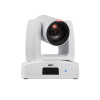Optimized the Onvif protocol for integration with Bosch meeting system
New Feature
- Enabled FQDN setting for direct access to the camera webpage using
“http://hostname”. If there are two cameras in the LAN pool with identical
hostnames, it may be difficult for the user to identify the correct one. Therefore,
modifying the hostname before using this function is necessary.
e.g. http://PTZ310UNV2 - Updated the NDI SDK to version 5.6 for NDI models in PTZ310UNV2,
PTZ330UNV2, TR315N, and TR335N
Improvement
- Optimized the Freed protocol and corrected the terminology from “FreeD” to
“Freed”. - Optimized the Onvif protocol for integration with Bosch meeting system.
- Optimized the auto operation smoothly movement in AI Auto Tracking function
on TR211/TR315(N)/TR335(N) models. - Bug fix: Corrected the VISCA command for the following:
CAM_BrightPosInq, CAM_Live Freeze, USB Status, UVC Status - Bug Fix: Corrected the display issue in NDI Studio Monitor where names were not
showing correctly for spaces. - Bug Fix: Resolved this issue where RTSP could not be activated when camera was
power off. - Bug Fix: Corrected the wording of SmartShoot and SmartFrame in the OSD.
- Bug Fix: Corrected bright mode setting in webpage.
Known issue
- We recommend using the Chrome browser for configuring webpages.
- When using NDI video theme mode, the USB video stream will be temporarily
paused in order to ensure the best possible NDI HX3 video streaming experience.
*Simultaneous outputs in different video theme modes:
PTZ310UNV2/PTZ330UNV2
Video modes
PTZ310UV2/PTZ330UV2
TR315N/TR335N
HDMI/IP/NDI HX2/USB (4KP60)
Standard/Teams/Zoom
PTZ211/PTZ231/TR315/TR335
HDMI/IP/USB(4KP60)
&
&
3G-SDI (1080P60) 3G-SDI (1080P60)
HDMI/IP/NDI HX3 (4KP60)
NDI
&
NA
3G-SDI (1080P60) - HTTPS: Enable HTTPS to establish a secure connection between the browser and
the camera. To enable HTTPS, please follow the steps below.
A. Obtain an SSL certificate in base-64 encoding format for encryption and
decryption, and a private key in PKCS#8 format (must be unencrypted).
B. Convert the required certificate content into PEM format. The SSL certificate
uploaded to the camera must be in PEM format.
C. In the HTTPS settings field, select "On", then click "Choose File" to select the
certificate file, and then click "Upload".

